Tibetan New Year

These photos were taken during the Tibet New Year in March, 1997 in far away Xiahe. Ghansu Province (which is known as a part of China but can be considered to be an area of Outer Tibet) .I have made inference to the Tibet New Year in text accompanying some of the Tibet etchings. (See Manjustri in the Iconography webpage in Part One and the Tibet etchings in the Travel webpage in Part 3). We (Kristina & I) were in Xiahe for approximately two weeks and the New Year festivities and rituals covered about four days. The Sunning of the Buddha seemed to us to be the main event. I have tried to find background information on certain rituals that we saw e.g. Dance of the Dead ( masked dancers who performed for five hours) ; the butter sculptures that were dramatically opened for public viewing one night and a parade of the remains of a noted high Lama through the town on the last day a well as the Buddha's sunning but have not been very succesful. I mention this as I can only give you my own personal meaning on what I saw and admit to my ignorance; so don't take my musings as gospel truth.The photos are more or less a 'visual montage' of the Tibetan New Year and at the moment in no particular order. Hope you find of interest. I wish to note that it was winter thus the air was very cold despite the sunny conditions; consider the fact that the butter sculptures were safe fom melting. The whole experience of the Tibet New Year ( which was soon after Chinese New Year) had an 'other world' sense about it and it was a high point of our overland Asian trip which had begun in Bali many months before. After the New Year we briefly visited Xining where there is a major Tibetan monastery and I believe we were in the vicinity of where the present Dala Lama was born. As it is many years since these photos were taken I have had difficulty labelling them but will do so for those photos that I know what they are about; these are my surviving photos as I took many more but I have misplaced both them and the negatives. Actually, one reason I am putting these shots on the website is that at least here they will survive. The specific camera I used was a small Nikon travel film camera with a small 28mm wide angle lense if my memory serves me correctly; otherwise it was probably 35mm). Most of these photos were taken 'on the run' so I confess they are not the best quality and present them here for historical/archival purposes. By the way the Tibetans did not mind having photos taken as long as one was discreet and not pointing a camera into people's faces etc.In fact, people seemed quite happy for pictures to be taken. After all such photos help to maintain a visual record/memory of a culture that is fighting for its very existence. Ciao.
________________________________________________________________________________________________
Below is a link to the Australia Tibet Council:
Also the following link provides international information to other Tibet support groups; I imagine this link would be of interest to people visiting this webpage who reside outside Australia.
http://tibet.dharmakara.net/TibetLinks.html
________________________________________________________________________________________________________________
________________________________________________________________________________________________________________
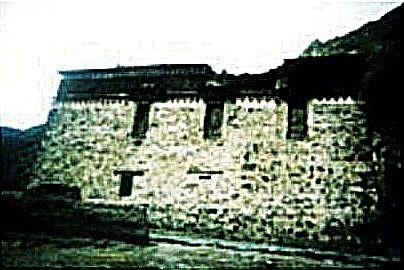
Ruined Tibetan monastery. (Although I never asked it could be presumed that it was attacked by the Chinese). This photo was taken while going off to visit an elderly senior monk who lived on his own in a small mudbrick house perched in the hills well outside Xiahe. His place was amazing but he preferred us not to take photos. It should be noted that at the time of the Tibetan New Year there was a sense that although the Chinese authorities tolerated this cultural event there were signs of a Chinese military presence but sensibly it kept to the background. It was interesting to hear how there was unrest in othe parts of China which would otherwise go unreported. An Irish journalist who I met told me of bombings in Urumqi in the vey west of China; mostly muslims live in this area and they seek independence from Beijing. In fact Xiahe had a very sizeable Muslim community; it actually felt it was half Muslim half Tibetan (it goes without saying Han Chinese also lived there). We used the local Muslim bath house to take hot showers. Altough I now digress one also saw on the trains rich Shanghai yuppies (as I called them) with their mobile phones etc sharing a carriage with extremely poor villagers with few belongings. The social chasm between the well-to-do and not-so-well-off is rather striking and one cannot help but feel that social unrest will be on the rise in a modernising China.
Monk's house
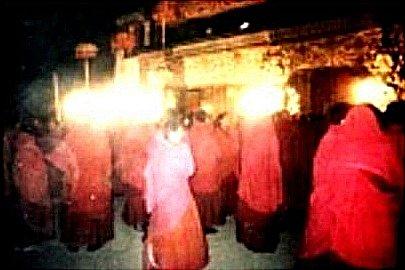
Butter sculpture night. Hundreds if not thousands of people waited outside the temple where the butter sculptures were on display. Theoretically people were suppose to be waiting in a line but the crowd became impatient although they were cheerful and seem to be making rather sardonic remarks to whoever was suppose to be in control. Eventually the restless crowd was allowed in and it was bedlam as this cheeky crowd disregarded any authority figure to have a look although there was a clear display of respect towards these statues. We got caught up in the big rush but it was a very festive mood that predominated on this eventful,exciting evening. The Tibetans to me a feisty people.
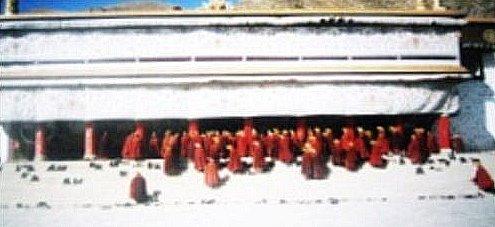
Singing monks. Every morning - very early morning in fact - many monks would arrive at the steps of this temple and begin to sing and 'chime' those deep throat sounds. It was astounding to hear them and equally incredible to consider their sense of self-discipline to sing in such freezing cold.
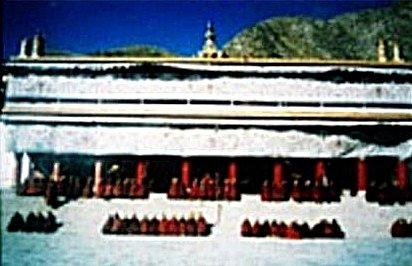
Singing monks.
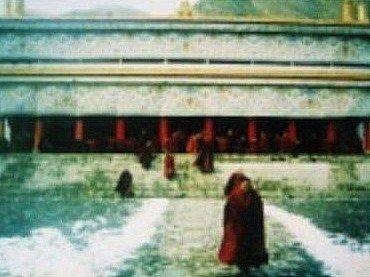
Monks arriving at temple
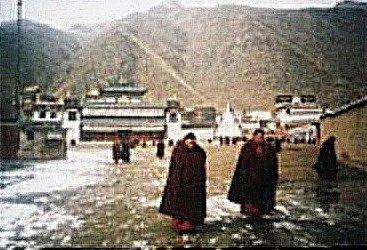
Monks leaving temple
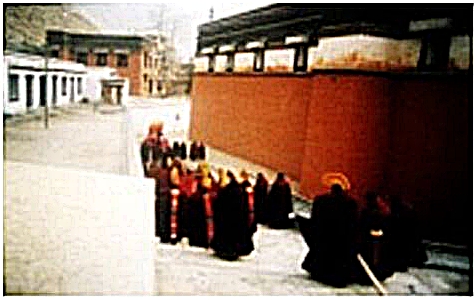
Monks. Xiahe.
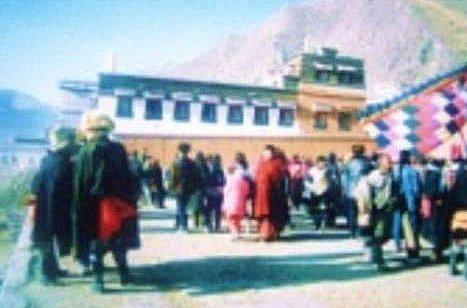
Tibetan crowd on roof of temple. Often there were many people waiting around for an event to occur and on one occasion we saw a large crowd wait for monks to appear from a temple doorway so they could be sprinkled with holy water. it was a very significant event for these people.
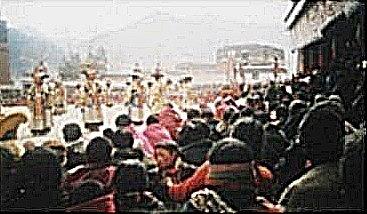
Dance of Death (or dance of the dead?). These monks in their special outfits, hats and masks ritually danced for over five hours. I stayed the whole time and found that reference for time disappeared and focusing my mind on these performers seemed to take me outside time to that spectrum we call the eternal. The dancers would move in as a circle and move out and I ersonally correlated this movement with the heart beating or breathing of the universe.
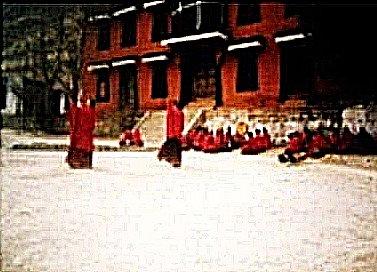
Ritual dancing monks. They may have been practising for the death dance or for other ritual dances. The monks sitting down were singing or chanting.
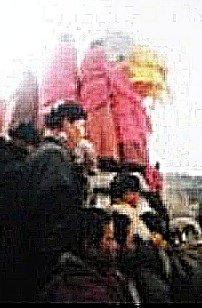
Crowd looking on at unfurling of the giant thanka at the Sunning of the Buddha.
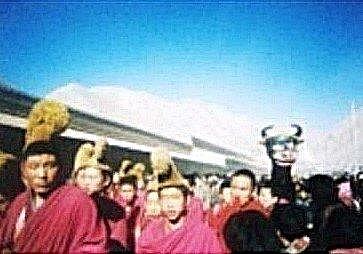
Crowd control cow. The cow would push people back from the carriage containing the holy bones from the long dead monk.
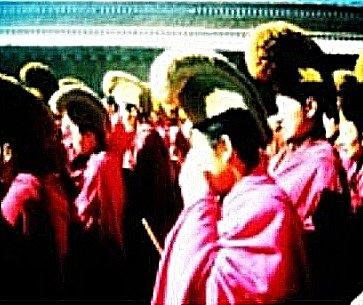
Monks following parade.
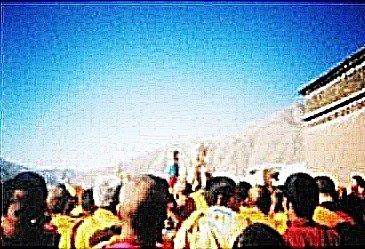
Parade crowd.
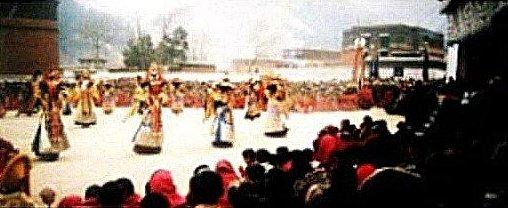
The Dance of Death. Xiahe.
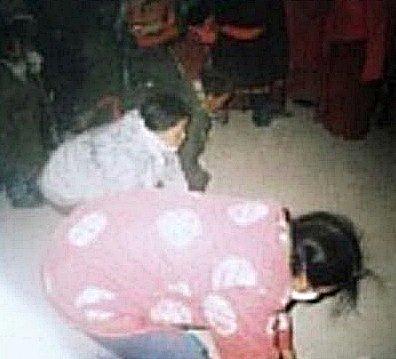
Pilgrims at Butter Sculpture night.
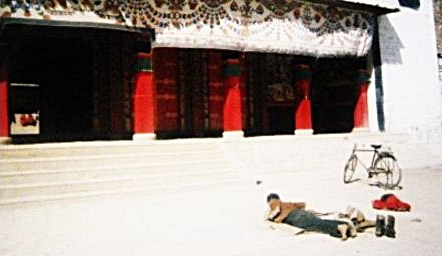
Pilgrim on ground in front of temple. Xiahe. Such a man it is said had come on his hands and knees from Lhasa.
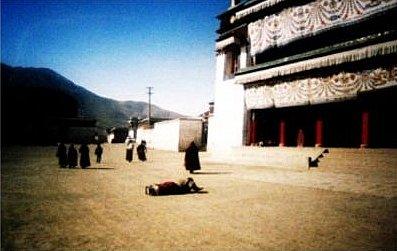
Another pilgrim outside temple. Xiahe.
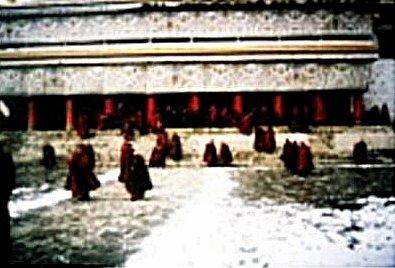
SInging monks leaving.
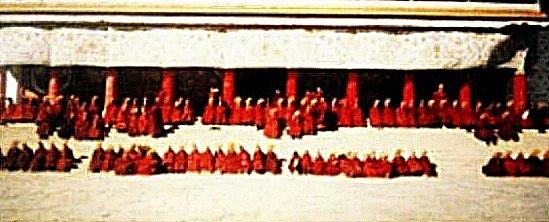
Singing monks.
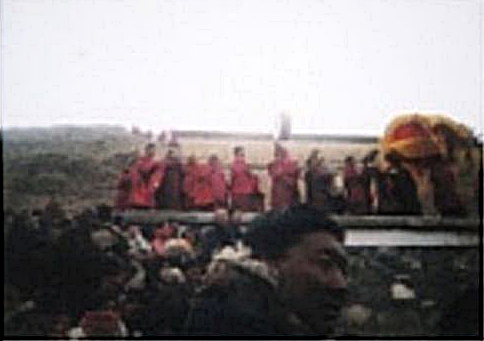
Unrolling the thanka
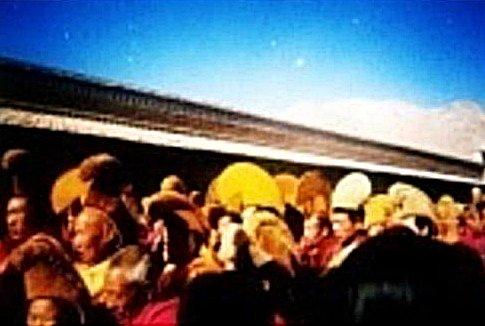
Monks on parade.
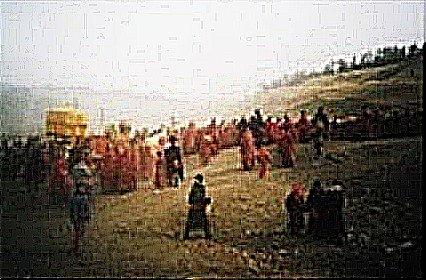
Thanka procession and surrounding crowd. This photo does not clearly show it but there are many monks holding a large roll that is the thanka that will be unravelled down a hill.
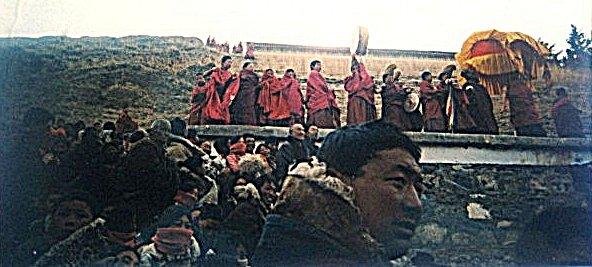
Thanka ceremony
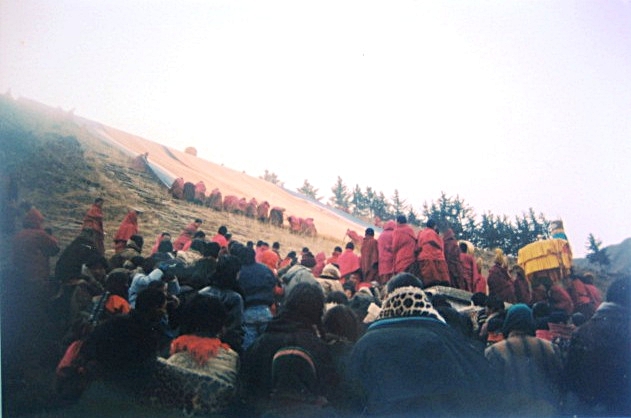
Unfurling the thanka
The same photo but taken a few seconds earlier than the previous one.
Thanka procession
Thanka crowd
Crowd watching thanka procession
Crowd watching thanka procession
Thanka crowd
A pleased spectator
Tibetan women watching monks practicing dance rituals
Xiahe
Xiahe
Xiahe backstreet
Xiahe temple
Temple doorway

Chinese soldiers marching down street all wearing white flowers in their lapels to signify their observation and respect for Premier Deng the leader of China who died while we were at Xiahe. On the day of Deng's funeral which was televised throughout China there were only empty streets and a silence over Xiahe. I can only talk for myself and not on behalf of the people of Xiahe but it seemed like protest through the total ignoring of China's leader passing away.
Ghostly Deng. On this little television in our pensione we watched his funeral.
Kristina standing on top of the pensione looking over Xiahe's main street and all 'dressed up' on a typical cold but sunny day.
Butter sculpture
Butter sculpture festival night; you will notice behind the elderly gentleman a man holding a stick who is meant to be 'crowd controlling'; the crowd was 'bemused.'
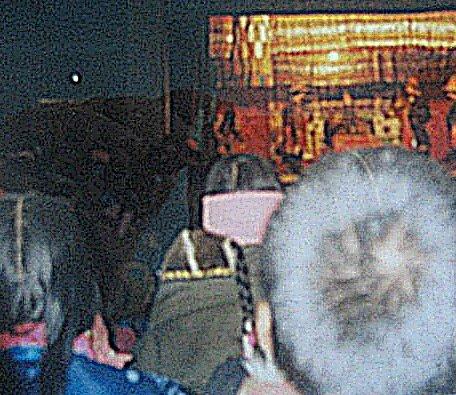
Outdoor night play
Small thanka with demon
A monk up a telegraph pole
Xiahe
Xiahe
Xiahe
Muslim owned wagon
Muslim man
_______________________________________________________________________________________________________________